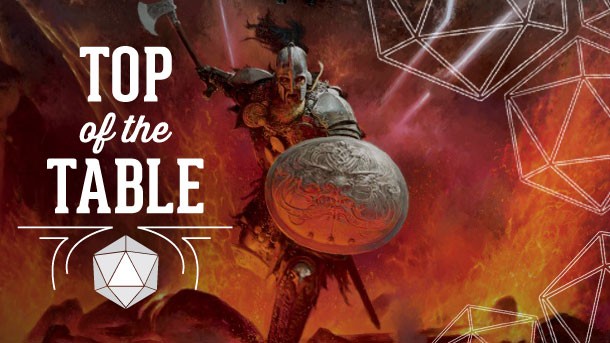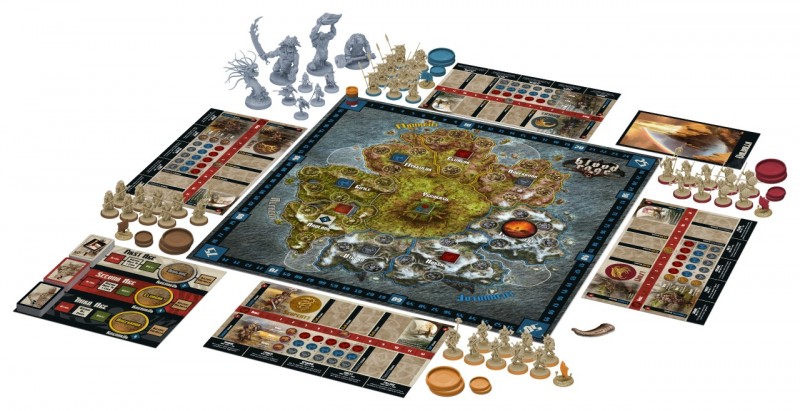Top Of The Table – Blood Rage

A few weeks back, I looked at Flick ‘em Up, one of my favorite casual games to play with family and friends, thanks to its simple rules and rewarding dexterity-based gameplay. If you’re more of a classic strategy gamer, this week’s spotlight should be right up your alley. Blood Rage is hands-down one of my favorite strategy board games of recent years. Challenging tactical decisions and a richly imagined Viking mythology theme drive the gameplay, accentuated by some awesome miniatures and excellent art by Adrian Smith. But it’s the briskly moving turn structure, intricate balance, understandable rules, and quick play times that help to distinguish Blood Rage from many of its competitors in the genre of area control war games; it’s a standout example of the way modern board-game design can be accessible and deep at the same time.
Blood Rage puts each of two to four players in charge of a Viking clan as the world marches toward its own destruction. The only thing to do is to venture forth into battle, winning as much glory as possible before Ragnarok sweeps the Earth clear. Battles unfold on a gorgeous map board that echoes classic Norse mythology; a center locale of the World Tree Yggdrassil is surrounded by provinces like Utgard and Muspelheim, and bounded on the outside by ocean and fjords, where clan ships can support your invasions. Villages lay scattered across the realms, ready to be conquered and pillaged, but only if you can defeat your fellow players who also seek to gain the upgrades that come with holding an area. As the game marches forward over a set period of three Ages, the world slowly crumbles apart; entire provinces tumble away into oblivion as all existence teeters comes closer to ruin. All the while, your warriors fight, die, go to Valhalla, and return to battle once again, all in the pursuit of glory, and aided by the machinations of gods like Loki, Thor, and Heimdall.
Designer Eric M. Lang crafted an elegant game flow that borrows liberally from popular recent successful board-game mechanics, but the emerging experience feels unique and strategically complex. While the war is fought on the big game board, for most players the focus of attention is your own clan sheet. Here, you can track your stats, upgrades, and available actions on each turn. Build up your Rage stat, and you can take more actions. Focus instead on your Axes stat, and you gain more glory for each battle. Or gain a higher Horns stat, and be able to field more troops. Your decisions and rewards during the game dictate the way each statistic changes; while every player begins with their clan equal to the others, the later Ages of a given game session tend to have vastly different statistics for each player.
In each Age, players complete a card draft, taking a single card from a group, and then pass the remaining cards to the next player. Your chosen cards dictate the focus of your strategy in the action phase that follows, from quest cards that reward glory for a secret objective, to cards that will aid you in battle. Each card is tied to a particular deity, and each provides their own suggested path to victory. Focus on Loki cards, and your gameplay is all about revenge and engineering your own defeat in battle. Far-seeing Heimdall grants boons all about foresight and surprising your foes. By focusing on cards from a couple of gods and their related strategies, you gain an advantage. However, focus too much on one god, and your opponents will quickly learn how to get the upper hand.

With cards in hand, turn order goes around the table, letting you invade villages, march deployed troops to new locales, upgrade your clan, recruit monsters to your cause (represented by their own awesome minis), commit to a quest, or pillage a province. In that final situation, battles break out between any nearby clans, all vying for both the reward of that province, and the glory of defeating enemies in battle.
It’s here in these battles that Blood Rage shines brightest, as the goals are different than in most war games. Usually, in games of this sort, competing players are simply looking to outwit their opponents and win the fight. But when part of the victory condition might be a card that provides glory for defeat, or glory for soldiers killed and sent to Valhalla, the dynamic changes. Over-committing to a battle can often play right into your opponent’s hands, as you sacrifice cards to add strength to your attack, even as they are happy to take the loss. And to add yet another layer, the greatest glory comes to Viking warriors who die as a province comes crashing down around them at the end of the Age, providing the incentive to marshal your troops into a doomed region, and holding it against aggressors.
Blood Rage has a rich array of strategic choices at every step of the way through an evening of gaming, but its limited player count and smartly presented rules keep play times around two hours, in my experience, or even less with experienced players. The dramatic scope of the Norse mythology is realized with aplomb, from the detailed unpainted minis to the attention spent on reflecting the whims of the different gods; everything reinforces the Viking dynamic. Add to that the Ragnarok mechanic, and there’s a desperation and thrill to every turn, as the world keeps shrinking and battles grow fiercer.
Blood Rage has been out for a couple of years now – I highlighted its original release as one of my favorite tabletop games of 2015. In the time since, even as the core game offers a phenomenal standalone gaming experience, players have also been able to expand their game in several ways. A fifth player expansion can be snagged if you need to support a slightly larger gaming group. The Mystics of Midgard pack adds new mystical units to each clan, and their powers grow over the course of the game to reshape your strategic options. And the Gods of Asgard expansion actually sees some of the mighty deities descend into the fray, occupying provinces and creating both dramatic obstacles and opportunities for canny strategists.
If you’ve been longing for a deeper strategy war game for your group, but you’ve been unsure about where to start, you can hardly go wrong with Blood Rage. While it’s a recommendation I’d happily pass along to even longtime veteran players, it’s the ease of play and learning that I most appreciate about Blood Rage, making it an ideal fit for groups that are ready to graduate to this kind of deeper experience. And let’s be honest; Viking warriors battling for a place in Valhalla is an engaging concept in the first place.
If grand Norse wars aren’t exactly what you’re looking for, you may wish to peruse some of the other recent games in our Top of the Table hub, which you can reach by clicking on the banner below. For a curated list of some of the best recent releases, consider checking out picks for the best tabletop games of 2016. And if you’d just like some personal recommendations, drop me a line via email or Twitter. Thanks for reading!


Get the Game Informer Print Edition!
Explore your favorite games in premium print format, delivered to your door.
- 10 issues per year
- Only $4.80 per issue
- Full digital magazine archive access
- Since 1991









